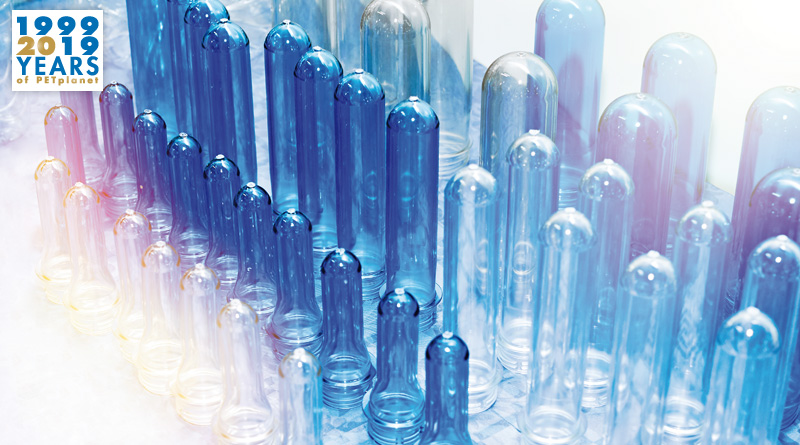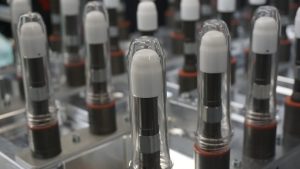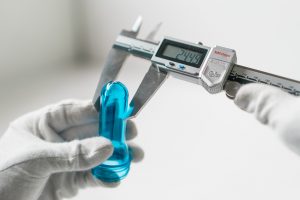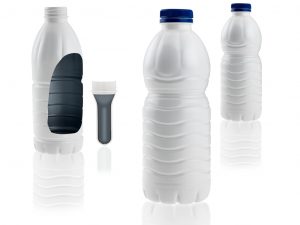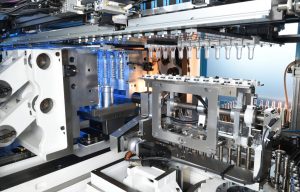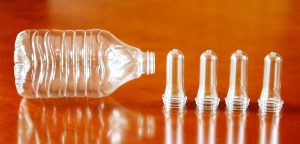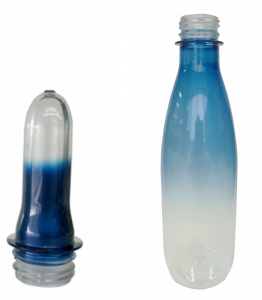A review of preform developments
When designing preforms, a number of parameters have to be defined, like the overall shape, the neck finish and mechanical and barrier characteristics that need to be achieved. The length of the preform results from the bottle’s height (minus neck) as well as the axial stretch ratio, while the core diameter results from the Hoop stretch ratio and the bottle’s diameter. The preform wall thickness results from the bottle wall thickness multiplied by the biaxial stretch ratio.
To produce PET bottles, preforms have to be manufactured and stretch blow moulded. Both processes can be carried out independently using different machinery (2-stage process) or in a single-stage process. In the 1-step or single-stage process, PET resin is melted and moulded into a bottle in one machine, using residual preform heat from the injection or injection-compression process to blow mould bottles into an equal number of blow cavities.
In the 2-step process, preforms are manufactured on injection moulding machines as a first step by melting and moulding the PET resin. The finished preforms with a complete neck can then be re-heated and stretch blow moulded into bottles in stretch-blow moulding machinery in a second step.
In 1995, Nissei ASB developed the 1.5 step moulding method, in which preforms are injection moulded, partially cooled to maximise stability and then temperature conditioned before being passed to a blow mould. This blow mould usually contains a third of the number of cavities of the preform mould (as it takes three times longer to injection mould preforms than to blow bottles).
Each process has its advantages and disadvantages in terms of output or flexibility (amongst other factors), and preferences changed over the years. Enjoy the journey through 20 years of PET preform developments, the last topic of our jubilee year series!
PET preforms – some highlights 1999-2019, as reported in PETplanet Insider
1999
In our first issue, a 3-layer preform system was presented by Demag and installed at Kulleborn & Stenström in Sweden. Recycled material was used for the inner layer. At that time, the Swedish company produced 70 million preforms for 0.5 l bottles for Coca Cola.
2000
In issue 6, Husky presented a 60-cavity Quad Index machine as a further development of the Index range introduced in 1997. With this, a 7 sec cycle time could be achieved for 0.5 l preforms.
2001
PETplanet’s first book “Dressed to fill” was published. Cycle times of 14-16 sec for preforms with wall thicknesses of 3.0-3.6 mm were by then standard.
Issue 6 saw Netstal’s new 144-cavity preform system with a cycle time of less than 11 sec for a 20.8 g preform. The machine was shown at that year’s K show. The tool came from MHT.
We featured the first vertical Krauss-Maffei preform system for many years in issue 8, with a 24-cavity tool from Otto Hofstetter.
In issue 9 Robert Schad, back then CEO of Husky, expressed hesitation with regard to taking up the 144-cavity challenge laid down by Netstal. At the following K trade show, a 144-cavity micro-pitch tool (at least a display model) was shown on the stand (as reported in issue 11+12).
Also in issue 9, MHT presented the micro-pitch tool in detail. It allowed 72-cavity tools to be run on a 300 t machine rather than the usual 48 cavities, and a 144-cavity run on a 600 t machine which previously could run only 96 tools.
Arburg featured the vertically orientated Preliner in issue 11, with 130 t and 220 t versions for up to 16 cavities.
2002
We saw the first Krupp preform system in issue 10, under the Engel name. The range, rebranded as MacPET, had undergone a major overhaul by Engel and covered machines from 250-500 t.
2003
Husky presented the new developments of the Index machine in issue 8. The machine now went up to 600 t and 144 cavities. Cycle time for lightweight preforms was 5.7 sec. Of even greater importance for the future was the presentation of the HyPET preform systems, which were to slowly replace the fully hydraulic G range.
2004
A Husky advertisement announced for the first time that in addition to the standard 300 t and 600 t machines other sizes were available.
In issue 9, Netstal talked about their 96-cavity system for 20 g preforms with a 9.66 s cycle time.
Some of the big names talked about the need for a 196-cavity system in issue 12. Mike Urquhard, at the time at Husky, saw his 144-cavity system as sufficient for big quantities. Otto Hofstetter posed some critical questions concerning the economics of such a system, and Waldemar Schmitke, then at Netstal, presented for the first time the Netstal 196-cavity system, asking whether that would now be the end of the “cavity race”.
2005
Manfred Lausenhammer of MHT said in an interview in issue 1+2 that they had built a 196-cavity tool and reported sales of over eighty tools with 144 cavities. He believed in a market for the 196-cavity system, too.
Another machinery manufacturer appeared on the horizon: Chen Hsong who had been at the 2004 K show edition presented their 48-cavity system in issue 1+2.
2006
Netstal showed their 196-cavity system for the first time at NPE (issue 5).
In the following issue, Husky published a table that showed a 216-cavity tool for the 65 t HyPET 650.
2007
Otto Hofstetter announced the next stage in the “more cavities, less tonnage” race (issue 7): 128 cavities on a 350 t system set a new benchmark. We recall, in 2001, 96-cavities on a 600 t system made headlines!
Also in issue 7, Sacmi presented their PAM preform compression moulding system.
Netstal announced their new, small 200 t preform system in issue 11, covering the range of 24-60 cavities.
2008
The continuous process of compression moulding preforms ensures that all preforms are exactly the same – as shown by Sacmi at an Open House in Italy at a prototype machine (issue 3). Processing the material at a 10-15 °C lower degree than IM eliminates the AA problem.
In issue 5 we reported for the first time about Netstal’s Prelactia solution, the co-injected multi-barrier preforms for the dairy sector.
2009
Preform production taking place at an altitude of 5,000 m: Husky reported the successful installation at Glacier Mineral Water in issue 5.
Netstal managed to squeeze 60 cavities onto their small 200 t machines using an Otto Hofstetter tool (issue 9).
Husky caught the eye in issue 10 with a special preform system for direct processing of PET containing a high percentage of flakes.
2010
For issue 3 we visited AMD in India which was then producing 18,000 t of preforms per year on a vertical KraussMaffei system.
Netstal moved towards reducing energy consumption on their PETline systems (issue 4) but also towards achieving shorter cycle times. The newly developed Calitec system had been installed in Netstal systems with up to 192-cavities.
In issue 7+8 GDXL featured its patented conical-base preform, saving weight and material. On the market since 2006, it had now come into operation at Coca-Cola in China.
At K show, Netstal showed a new version of its PETline platform, operating with 60 cavities at 2,000 kN clamping force (instead of 3,500 kN previously). 0.5 l preforms were produced at a cycle time of 9 s (issue 9).
Also at K, Husky launched its H-PET AE (all electric) preform injection moulding system (issue 10). The small system addressed the needs of consumers in emerging markets and low-volume producers.
2011
A new competitor in the preform tooling sector: in issue 1+2 Mold-Masters presented its complete preform system. Using their patented conformal cooling technologies called iCool, the company developed a complete mould solution for preform moulding.
Issue 3 saw preform production containing up to 100% of PCR. Sipa’s preform injection moulding equipment designed for this function ranged from 96 down to 24-cavities.
In the same issue, Husky introduced a recycled flake system, the HyPET RF, with an injection unit specifically designed for recycled flakes.
Custom-made preforms were making a significant contribution to turnover for Retal Dnipro when we visited them in 2011 (see issue 4), and lightweighting was the need of the hour. For the 0.5 l bottle, the preform was slimmed down from 26 to 15.7 g.
“Investing first, then getting orders” was the mantra of Rajat Kedia when we visited Manjushree in Bangalore (also issue 4). Being the first and then only company in India to have their own preform tools, they became the largest preform producer in India.
Issue 12 reported on Netstal taking over the PET activities from Krauss-Maffei. Whilst KraussMaffei had in its PETform series opted for vertical clamping, Netstal has built classic horizontal clamping into the PET-Line series.
2012
Netstal’s LightBase process reduces weight while improving material distribution. Specially designed base geometries optimise preform surfaces for the heating process, thus better absorbing the thermal energy. Later in the blowing process this leads to thinner walls. (Issue 1+2).
Reducing thickness where the wall is at its thickest – Sipa concerned itself in issue 1+2 with bottle necks and produced light containers; the thickness and weight of the neck is determined by the preform injection moulding process.
Sipa tackles the high output volume sector: At NPE, the company introduced a new PET preform moulding system. In issue 3 we introduced the new development, which accepted moulds from all leading mould makers.
In the very same issue we reported that Sacmi had made a new start in the preform sector. IPS, standing for Injection Preform System, was presented at Plastmilano exhibition, sporting 48-cavities and a clamping force of 220 t. Rapid mould change was a special focus.
2013
In issue 4, Jeff MacDonald, then Vice President Marketing at Husky, explained in an interview that the average number of cavities for preform systems has peaked. Instead he saw a decline, as the average number supplied was between 72- and 96-cavities per system. The basic reason for this: better technology equals improved performance per cavity.
Netstal featured at Drinktec the PET-Line 2400 and issued an invitation to view the new PET-Line 4000, equipped with new features. The 72-cavity mould was provided by Otto Hofstetter. Cycle time was 5.4 sec. (Issue 7+8)
In issue 9, Dr Golz, then President Krauss-Maffei and Netstal, spoke about plans to relocate KraussMaffei’s PETForm range of machinery to Netstal’s location in Näfels, Switzerland. Nevertheless, Netstal would continue to act independently in the market.
A preform system based on injection compression moulding was presented by Sipa at Drinktec (issue 11). “Xtreme” was claimed to offer new design possibilities and weight savings as injection compression moulding allows for thinner walls and a thinner base area than injection moulding. On display at Drinktec was a 72-cavity solution, producing 8.7 g preforms (0.5 l).
In issue 12, Husky announced the launch of HyPET HPP5 preform moulding system. A 12% increase in productivity was stated as well as a greater freedom in preform design.
2014
At K 2013 Nissei ASB exhibited machinery featuring their 1.5-stage process. In their PF series, the preform is injection moulded, partially cooled, temperature equalised and re-heated before being blown (issue 3).
2015
One year after the launch of the new model series with PET-Line 2400 and 4000, Netstal presented the new 5000 model for moulds with up to 144 cavities, featuring faster cycle times and energy savings compared to previous models, as we reported in issue 1+2.
In issue 3 we reported about Sipa bringing together its preform compression moulding system with a stretch-blow moulding unit in one machine. Xtreme Sincro claimed to produce preforms up to 10% lighter than any preforms produced by conventional injection moulding without losing any key properties.
For the same issue, we visited Husky in Canada and learned that the recent trend towards smaller PET bottles could cause issues with shelf life in certain environments. So the time was considered right to launch a barrier module, built on the HyPET HPP5 platform.
Several brands including Kortec and Mold-Masters were united under the Milacron banner. At NPE, a new servo-hydraulic PET system was presented with the M-PET 300. (Issue 4)
Sacmi presented its new IPS 400 for up to 128-cavities in the same issue. It featured a post-cooling system with preforms unloading directly into boxes. On a demonstration in Imola, Italy, a 11 g preform was produced with a cycle time of 6.2 sec. on a 96-cavity MHT mould.
For issue 9, we visited Yizumi Precision Machinery and its injection moulding machinery at Chinaplas. Their then new model PET-72A2 was designed for up to 96-cavities with energy-saving preform handling.
Almost 300 different types of preforms for all neck finishes and weights were in the portfolio of Resilux when we visited them in Spain in 2014. Replacing aluminium with PET in the spray container sector was on their agenda back then.
The production of two-layer preforms manufactured using the overmoulding technique to protect light-sensitive content was presented in issue 11 by Netstal, offering a new PET line variant with, the 2C, with two injection moulding unites for this. Preforms could be fitted with a thin, dark-tinted inner layer.
2016
The IM process does not allow further reduction of material in the area of the injection point, resulting in a waste rate of 2-10% of PET material in bottle bases. This is what Creative Packaging Solutions (CPS) stated in issue 4. The solution Mint-Tec presented together with Netstal, Otto Hofstetter and MHT is a mechanically optimised base design of the preform, saving up to 4% material.
In the same issue we depicted the M-PET 300 preform line, which Milacron was displaying at NPE. Rich Sieradzki, VP and GM of PET Systems defined the dairy market as the development’s main target, especially in conjunction with Milacron’s multi-layer technology.
For issue 9, we paid a visit to the French preform giant SGT. On its 21 preform machines, more than 200 different models could be delivered with 19 different neck sizes. At the time, SGT aimed at further investments and at doubling the rPET content in their preforms.
In China, we visited machinery and mould manufacturer Guangzhou Huayan Precision Machinery (issue 10). With around 600 of an estimated 1,100-1,200 PET preform injection moulding machines in the market, it held a 55% market share.
At the K show, Sipa demonstrated the production of ultralight preforms on its Xtreme injection compression moulding machinery. A 6 g preform for a 500 ml container was claimed to be possible. For the production of preforms made from 100% post-consumer PET flakes, Sipa partnered with Erema, resulting in the Xtreme Renew. (Issue 12)
2017
How to act in a very price-sensitive market without compromising on quality was explained to us by PT Namasindo Plas in Indonesia (issue 5). To offer the “lowest preform prices in the world”, the company manufactured very high quantities of just a few standard preforms in three sizes. Thus, 390 ml bottles as well as 535 ml bottles are both produced from a 600 ml preform.
In issue 6, Husky gave an overview of technological approaches to improve barrier performance. One of them is their multi-layer technology where a preform is produced in sequential injection or a simultaneous co-injection process. The barrier layer is then sandwiched between inner and outer layer of the preform.
In the same issue, KHS presented material saving solutions in the neck and thread area – especially important for those who buy their preforms per weight.
With the GEN4 hot runner design concept, Sipa manufactured the first 180-cavity preform tooling in the world. Fitting on a regular 500 t machine that would normally run with 144-cavities, output could be increased without stressing the machine with fast cycle times.
Large-scale preform manufacturer Chemco explained which factors have to be considered to define the perfect preform for customers. Besides light weight, other factors like installed equipment, required barrier qualities, country’s requirements or even geographical aspects have to be considered.
In issue 9 we were introducing the joint venture between Otto Hofstetter and Yudo which enabled them to offer complete preform systems.
In an interview with PETplanet, Robert Schad from Athena Automation (now Niigon) explained how they achieved industry-leading cycle times and low energy consumption. The trends he foresaw for the preform sector were diversification, quicker mould and tooling changes and smaller systems.
At Drinktec, Husky presented its multi-layer technology for the first time live on a trade show. On the HPP5, a 17 g CSD application was produced at 8.7 s with a 72-cavity mould.
Issue 10 saw the direct processing of washed PET flakes into food contact grade preforms in the PET Inline Preform system. The system combined Erema’s Vacurema technology with Sipa’s Xtreme preform production system.
2018
At NPE, Husky paired its multi-layer technology with new recyclable barrier materials and highlighted the capability for various application requirements such as barriers for light, oxygen and carbon dioxide. (issue 5)
At Chinaplas, Netstal had shown its Prelactia solution, dual-layer preforms for milk bottles. During the first step of the overmoulding process, a 1mm inner grey layer is injected. The dark colour creates the light barrier to protect the dairies.
The third generation of its Eco300/2500 injection moulding machine was presented by Demark at Chinaplas, as we reported in issue 7+8. Energy efficiency and closing times had been especially on the radar for improvement, resulting in a confirmation of acceptance by Coca Cola.
Nissei ASB presented updated versions of its 1.5 step moulding machineries at CBB (issue 10). The model on stand was the PF36/36-600, moulding 36 preforms/cycle, producing bottles of up to 600 ml capacity.
For issue 12 we paid a visit to Retal Pennsylvania, where they were set up to produce, amongst others, three billion preforms on 400 or 500 t machines.
Our way led us also to Sipa’s Open House in Vittorio Veneto where the latest development was shown, the Xtreme blocked with a stretch blow moulding and filling line. So the process from PET flakes to bottles can be realised in one thermal cycle. The energy input in the preform injection-compression moulding is sufficient to produce the finished bottle.
Sacmi widened their IPS machinery range to achieve 60,000 preforms/hour. Lightweighting could also be improved, resulting in preforms weights of 4.5 g (25 mm neck).
Retal explained in the same issue the adjustments which had been made to realise a 6 l container as a successor of a 5 l container, but with the same weight and improved performance.
2019
Nissei ASB moved preform cooling from the injection station to the conditioning station (issue 1+2). Called “Zero Cooling”, the injection station is ready for the next cycle without cooling waiting times, increasing productivity by a factor of 1.5.
In issue 3 we reported on Huayan’s journey to the US. Many of their designs are intended to lightweighting, just as the then new 4.0 g preform for 250 ml bottles.
GDXL featured at Chinaplas its multi-layer co-injection solutions, allowing gradual colour change along the preforms. The solution can be achieved by modifying injection equipment into a co-injection system. (issue 5)
How preform storage can affect a bottle’s performance was discussed in an article by PTI in issue 7+8. As a rule of thumb, the older the preform, the more difficult the processing; and while drier preforms stretch less, moisture is more impactful on the properties of larger diameter preforms.
Stefan Bock, CEO of ReduPET explained in issue 10 why injection moulding and stretch blow moulding do not fit perfectly together, and how weak points can be overcome.
During our Editour India we learned at Chemco that the trend towards small packaging sizes means that overall output is declining. The company manufactures preforms for Coca Cola’s 250 ml bottle, and planned developments in the area of multi-layer.
Nishant Mouldings from India manufactures almost 200 different preform designs, from 7.6 g to 735 g and 25-120 mm neck size. Sustainable manufacturing was on the company’s top agenda (issue 11).

